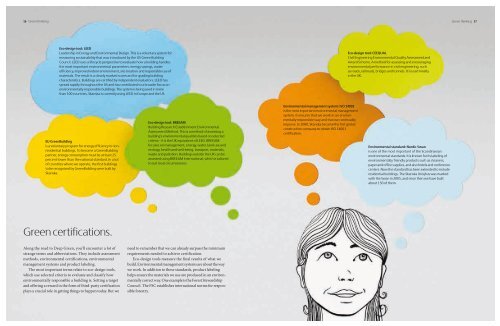Green thinking - Skanska
Green thinking - Skanska
Green thinking - Skanska
- No tags were found...
You also want an ePaper? Increase the reach of your titles
YUMPU automatically turns print PDFs into web optimized ePapers that Google loves.
16 <strong>Green</strong> <strong>thinking</strong><strong>Green</strong> <strong>thinking</strong> 17Eco-design tool: LEEDLeadership in Energy and Environmental Design. This is a voluntary system formeasuring sustainability that was introduced by the US <strong>Green</strong> BuildingCouncil. LEED uses a lifecycle perspective to evaluate how a building handlesthe most important environmental parameters: energy savings, waterefficiency, improved indoor environment, site location and responsible use ofmaterials. The result is a clearly marked scorecard for grading buildingcharacteristics. Buildings are certified by independent evaluators. LEED hasspread rapidly throughout the US and has contributed to a broader focus onenvironmentally responsible buildings. The system is being used in morethan 100 countries. <strong>Skanska</strong> is currently using LEED in Europe and the US.Eco-design tool: CEEQUALCivil Engineering Environmental Quality Assessment andAward Scheme. A method for assessing and encouragingenvironmental performance in civil engineering, suchas roads, railroads, bridges and tunnels. It is used mostlyin the UK.EU <strong>Green</strong>Buildingis a voluntary program for energy efficiency in nonresidentialbuildings. To become a <strong>Green</strong>Buildingpartner, energy consumption must be at least 25percent lower than the national standard. In a lotof countries where we operate, the first buildingsto be recognized by <strong>Green</strong>Building were built by<strong>Skanska</strong>.Eco-design tool: BREEAMBuilding Research Establishment EnvironmentalAssessment Method. This is a method of assessing abuilding’s environmental qualities based on selectedcriteria – it is the UK equivalent of LEED. BREEAMfocuses on management, energy, water, land use andecology, health and well-being, transport, materials,waste and pollution. Buildings outside the UK can beassessed using BREEAM International, which is tailoredto suit local circumstances.Environmental management system: ISO 14001is the most important environmental managementsystem. It ensures that we work in an environmentallyresponsible way and that we continuallyimprove. In 2000, <strong>Skanska</strong> became the first globalconstruction company to obtain ISO 14001certification.Environmental standard: Nordic Swanis one of the most important of the Scandinavianenvironmental standards. It is known for its labeling ofenvironmentally friendly products such as cleaners,paper and office supplies, and also hotels and conferencecenters. Now the standard has been extended to includeresidential buildings. The <strong>Skanska</strong> Uniqhus was markedwith the Swan in 2005, and since then we have builtabout 150 of them.<strong>Green</strong> certifications.Along the road to Deep <strong>Green</strong>, you’ll encounter a lot ofstrange terms and abbreviations. They include assessmentmethods, environmental certifications, environmentalmanagement systems and product labeling.The most important terms relate to eco-design tools,which use selected criteria to evaluate and classify howenviron mentally responsible a building is. Setting a targetand offering a reward in the form of third-party certificationplays a crucial role in getting things to happen today. But weneed to remember that we can already surpass the minimumrequirements needed to achieve certification.Eco-design tools measure the final results of what webuild. Environmental management systems are about the waywe work. In addition to these standards, product labelinghelps ensure the materials we use are produced in an environmentallycorrect way. One example is the Forest StewardshipCouncil. The FSC establishes international norms for responsibleforestry.

















